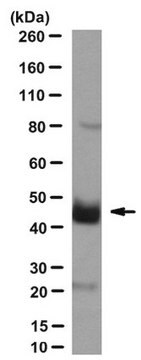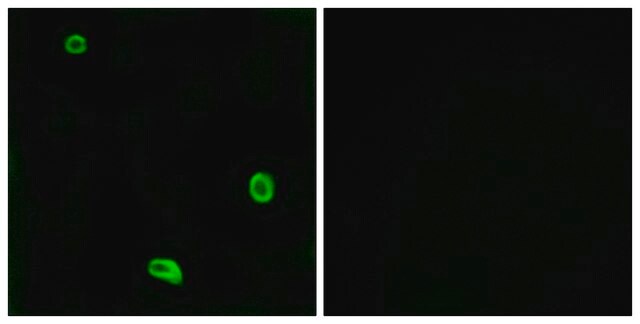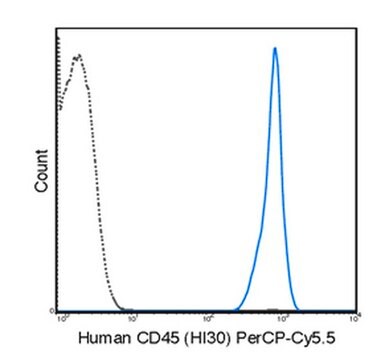MABS1298
Anti-PAR4 Antibody, clone 5F10
clone 5F10, from mouse
Synonim(y):
Proteinase-activated receptor 4, PAR-4, Coagulation factor II receptor-like 3, Thrombin receptor-like 3
About This Item
Polecane produkty
pochodzenie biologiczne
mouse
Poziom jakości
forma przeciwciała
purified immunoglobulin
rodzaj przeciwciała
primary antibodies
klon
5F10, monoclonal
reaktywność gatunkowa
human
metody
flow cytometry: suitable
immunocytochemistry: suitable
inhibition assay: suitable
western blot: suitable
izotyp
IgG2bλ
numer dostępu NCBI
numer dostępu UniProt
docelowa modyfikacja potranslacyjna
unmodified
informacje o genach
human ... F2RL3(9002)
Opis ogólny
Specyficzność
Immunogen
Zastosowanie
Immunocytochemistry Analysis: A representative lot detected the expression of exogenously transfected human PAR4 by fluorescent immunocytochemistry staining of 4% formaldehyde-fixed HEK293 Flp-In cells following tetracycline treatment (Mumaw, M.M., et al. (2015). Thromb. Res. 135(6):1165-1171).
Flow Cytometry Analysis: A representative lot detected tetracycline-induced expression of exogenously transfected human PAR4 on the surface of HEK293 Flp-In cells. Thrombin treatment diminished cell surface PAR4 immunoreactivity (Mumaw, M.M., et al. (2015). Thromb. Res. 135(6):1165-1171).
Inhibition Analysis: A representative lot, when added prior to thrombin, protected cell surface PAR4 against thrombin cleavage (Mumaw, M.M., et al. (2015). Thromb. Res. 135(6):1165-1171).
Western Blotting Analysis: A representative lot detected MBP fusion proteins containing human PAR4 fragment a.a. 18-78 or 41-66, but not 48-72. MBP-PAR4 fusion degradation by thrombin treatment ablolished target band detection by clone 5F10 (Mumaw, M.M., et al. (2015). Thromb. Res. 135(6):1165-1171).
Western Blotting Analysis: A representative lot detected tetracycline-induced expression of exogenously introduced human PAR4 in a HEK293 Flp-In cell line, as well as endogenous PAR4 in isolated human platelets (hPLTs). Thrombin activation of hPLTs diminished PAR4 target band detection (Mumaw, M.M., et al. (2015). Thromb. Res. 135(6):1165-1171).
Signaling
GPCR, cAMP/cGMP & Calcium Signaling
Jakość
Western Blotting Analysis: A 1:250 dilution of this antibody detected PAR4 in 50 µg of human platelet lysate.
Opis wartości docelowych
Postać fizyczna
Przechowywanie i stabilność
Inne uwagi
Oświadczenie o zrzeczeniu się odpowiedzialności
Nie możesz znaleźć właściwego produktu?
Wypróbuj nasz Narzędzie selektora produktów.
Kod klasy składowania
12 - Non Combustible Liquids
Klasa zagrożenia wodnego (WGK)
WGK 2
Temperatura zapłonu (°F)
Not applicable
Temperatura zapłonu (°C)
Not applicable
Certyfikaty analizy (CoA)
Poszukaj Certyfikaty analizy (CoA), wpisując numer partii/serii produktów. Numery serii i partii można znaleźć na etykiecie produktu po słowach „seria” lub „partia”.
Masz już ten produkt?
Dokumenty związane z niedawno zakupionymi produktami zostały zamieszczone w Bibliotece dokumentów.
Nasz zespół naukowców ma doświadczenie we wszystkich obszarach badań, w tym w naukach przyrodniczych, materiałoznawstwie, syntezie chemicznej, chromatografii, analityce i wielu innych dziedzinach.
Skontaktuj się z zespołem ds. pomocy technicznej







